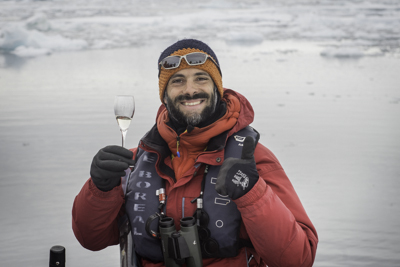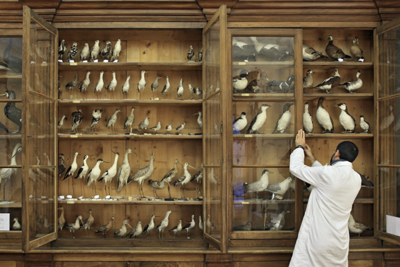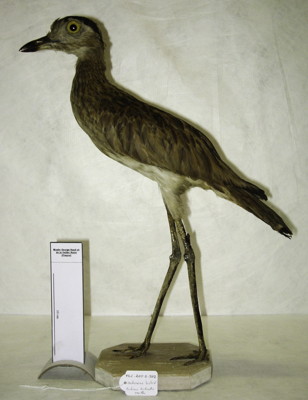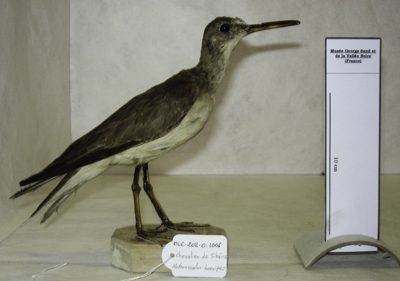The scientific and historical importance of small, old collections
In 1838, Ferdinand Joseph L’Herminier, a French botanist and zoologist born in Basse-Terre, Guadeloupe, published the first description of the Double-striped Thick-knee (vocifer), today known by the scientific name Burhinus bistriatus vocifer [1]. L’Herminier used six specimens to describe the species, which he originally named Ædicnemus vocifer.
One of the specimens that L’Herminier used for his description is housed in the Baillon Collection at the Musée George Sand et de la Vallée Noire, La Châtre, France. The Baillon’s inscription for the specimen indicates that it was sent by Florent Prévost, assistant naturalist at the Paris Museum, to Louis Antoine François Baillon, whose father started the Baillon Collection. The available information indicated that Prévost received the specimen from L’Herminier himself, but it was unknown who originally provided the specimen to L’Herminier. This question becomes even more intriguing when you consider that the Baillon specimen is the only surviving type specimen of the six originally used by L’Herminier for his 1838 description.
 |
| Christophe guiding on a Zodiac cruise in Antarctica (February 2015). © Lorraine Turci. |
Christophe Gouraud is an expert at solving the mysteries surrounding historic specimens. With a Masters degree in ecology and a specialty in ornithology, Gouraud spends much of his time working as a Polar guide on expedition ships that cruise in Spitsbergen, Greenland, Nunavut, the Russian Arctic, the South Atlantic islands and Antarctica, but before becoming a guide, he took part in many scientific expeditions related with birds in Alaska, Morocco, Kazakhstan, and Peru. Today, he still finds time to pursue his ornithological passion. Between the Arctic and Antarctic seasons, he works with bird collections in France, particularly within the Caire-Chabrand Collection at the Musée de la Vallée, Barcelonnette, France, and the Baillon Collection of La Châtre.
 |
| Christophe working on the Caire-Chabrand Collection, Musée de la Vallée, Barcelonnette, France. © Claude Gouron, http://www.claude-gouron.fr, https://500px.com/claudegouron/sets. |
Discovering information about historic specimens can be a difficult task. Access to historic literature is essential to successful investigations, and thus, Gouraud has found BHL an invaluable ally in his hunt for information.
“BHL is such a great, impressive and useful tool,” lauds Gouraud. “As I am not working in an institution with access to huge libraries, BHL has made possible what I have achieved so far. I don’t know if my work would have been possible without BHL, but for sure it is unbelievable the time that can be saved.”
Gouraud uses BHL to search for the original descriptions of bird species (most of which were described in the 18th and 19th centuries), to locate accounts of early voyages of exploration and discovery (during which many of the specimens he researchers were collected), and to explore references cited by the authors of the publications he consults for his research. When working on the history of a collection, he consults BHL daily, exploring multiple documents during each visit.
“In a few clicks, you can access, read and download (for free!!!) most of the documents you need,” exclaims Gouraud. “All that is needed is a good Internet connection. Through BHL, I can easily access so many old and rare books deposited in just a few institutions worldwide while simply sitting at home drinking a good coffee!”
Gouraud’s favorite BHL feature is the custom PDF download, which allows him to select specific pages of interest for his research and save them for future consultation. His extensive use of the library also revealed some areas where he believes improvements can be made. These include adding a full text search option to BHL, allowing users to search within the contents of a book; improving the OCR, allowing more scientific names to be discovered; and merging the redundant author and title names sometimes displayed throughout BHL.
Full text search is a high priority for future BHL development, with prototypes currently being investigated. BHL crowdsourcing games, Smorball and Beanstalk, are one method we are currently using to improve BHL’s OCR. Multiple instances of the same author or title in BHL result from differences in the library catalogs contributing information to BHL. While we try to automatically de-duplicate entries as they are ingested, not all duplicates can be merged automatically. We rely on feedback from our users to help us identify and allow us to correct duplications that do occur. Use our feedback form to alert us of any errors that should be corrected in the BHL portal.
BHL allowed Gouraud to solve the mystery of the origin of the Double-striped Thick-knee specimen housed in the Baillon Collection. By consulting L’Herminier’s original description in BHL, Gouraud discovered that the specimen was originally collected by Doctor Louis Daniel Beauperthuy, a physician and scientist born in Basse Terre, Guadeloupe, and the discoverer of the transmitting agent of yellow fever. Beauperthuy gave the specimen to L’Herminier, who used it for his description and then sent it on to the Paris Museum.
“I completed the story and linked Dr. Beauperthuy to L’Herminier only because I had access to the original description by L’Herminier,” explains Gouraud. He published his findings in the Bulletin of the British Ornithologists’ Club.
BHL has allowed Gouraud to uncover many fascinating details about the Baillon Collection. As another example, the Baillon Collection contains specimens collected during Louis Claude de Saulces de Freycinet’s three year voyage (1817-20) that cruised about the Pacific, visiting Australia, the Mariana Islands, Hawaiian Islands, other Pacific islands, and South America. One such specimen is a Grey-tailed Tattler (Heteroscelus brevipes), collected at the Mariana Islands. Sadly, the expedition met with tragedy when Freycinet’s ship, L’Uranie, wrecked in the Falkland Islands on 15 February, 1820, resulting in the loss of almost all of the expedition’s natural history collections. By consulting the account of the expedition in BHL, Gouraud discovered that specimens from 313 species survived the wreckage, and 12 specimens are now in the Baillon Collection.
Gouraud’s experiences demonstrate the multi-layered value of BHL’s collections. They are useful not only for providing information about species, ecosystems, habitats, and taxonomies, but also for historical investigations, such as uncovering the origins of museum collections. Gouraud has used BHL to uncover many other fascinating details about the Baillon Collection. You can explore some of these findings in his publications:
- Gouraud C., 2014: Eighteenth century bird specimens in the Baillon Collection, La Châtre, France. – In: Mlíkovský, J. (Ed.) Proceedings of the 8th Meeting of European Bird Curators, Journal of the National Museum (Prague), Natural History Series. 183: 19-28.
- Gouraud C., 2014: Extinct and endangered species and subspecies of birds in the Baillon Collection, La Châtre, France. – In: Mlíkovský, J. (Ed.) Proceedings of the 8th Meeting of European Bird Curators, Journal of the National Museum (Prague), Natural History Series. 183: 29-38.
- Gouraud C., 2014: The authorship of the name Ornismya Parzudaki (Aves: Trochilidae). – Zoological Bibliography 3(4): 63-68.
- Mearns R., Gouraud C., and Chevrier L., 2015: The identity of Richard of Richard’s Pipit (Anthus richardi Vieillot, 1818). – Archives of natural history 42(1): 85-90.
- Gouraud C., 2015: List of the type specimens of birds in the Baillon Collection (La Châtre, France). Part 1. Non-Passerines. – Bulletin of the British Ornithologists’ Club 135(2): 131-153.
Gouraud emphasizes that his research is made possible not only by BHL, but also thanks to Annick Dussault, director of the Musée George Sand et de la Vallée Noire (La Châtre, France) that houses the Baillon Collection, as well as the city of La Châtre, that gave him the opportunity of working with the Baillon Collection.
We would like to extend a special thanks to Gouraud for sharing his incredible work with us and demonstrating how BHL supports that work. Do you use BHL to support your own work? Want to be featured on our blog? Then send us a message to feedback@biodiversitylibrary.org!
[1] Dickinson E.C., Overstreet L.K., Dowsett R.J. and Bruce M.D., (Eds.) 2011: Priority! The Dating of Scientific Names in Ornithology: a Directory to the literature and its reviewers. Northampton, U.K., Aves Press.





Leave a Comment